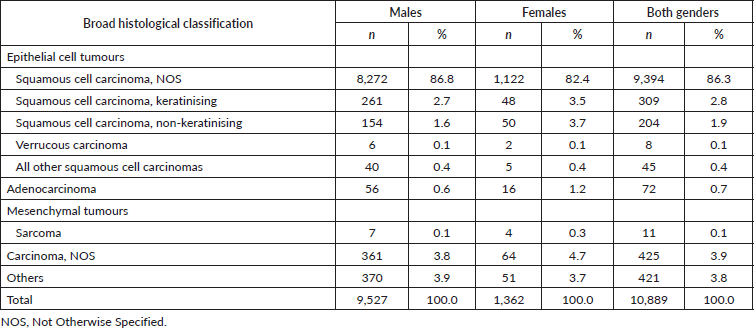Epidemiology of human papillomavirus related cancers in India: findings from the National Cancer Registry Programme
Thilagavathi Ramamoorthy, Krishnan Sathishkumar, Priyanka Das, Kondalli Lakshminarayana Sudarshan and Prashant Mathur
Indian Council of Medical Research – National Centre for Disease Informatics and Research, Nirmal Bhawan-ICMR Complex (II Floor), Poojanahalli, Kannamangala Post, Bengaluru-562 110, Karnataka, India
Abstract
Human papillomavirus (HPV) causes more than one-fourth of infection related cancers globally. The present study summarises the epidemiology of HPV related cancers in India, with a special focus on cervical and oropharyngeal cancer, utilising the National Cancer Registry Programme (NCRP) data. The data on HPV related cancer incidence and treatment were extracted from 28 population-based and 96 hospital-based cancer registries under the NCRP network. Incidence was presented as rates, clinical extent of disease and treatment provided as percentages. Joinpoint regression analysis was performed to calculate annual percent change in age adjusted incidence rates (AARs) over time. Incidence of HPV related cancers for 2025 was projected. Among all cancers, 7.5% were HPV related cancers. Cervical cancer (87.6%) and oropharyngeal cancer (63.2%) were the most common HPV related cancers in India among females and males, respectively. Cervical cancer was highest in Papumpare district (AAR: 27.7 per 100,000) and oropharyngeal cancer among males in East Khasi Hills district Population Based Cancer Registry (AAR: 11.4 per 100,000). In most PBCRS, cervical cancer incidence rate decreased significantly over the period of time. The majority of these cancers presented at locoregional spread stage of the disease and were treated with chemoradiation. The projected incidence of HPV related cancers is expected to increase to 121,302 by 2025. Implementation of effective prevention and control strategies like HPV vaccination and scaling up of screening could reduce the burden of HPV related cancers. Evidence from NCRP serves as the baseline to monitor the impact of HPV related policies and programmes in improving the outcome and prognosis.
Keywords: human papillomavirus, cervical cancer, oropharyngeal cancer, India, epidemiology
Correspondence to: Prashant Mathur
Email: director-ncdir@icmr.gov.in
Published: 07/09/2022
Received: 05/05/2022
Publication costs for this article were supported by ecancer (UK Charity number 1176307).
Copyright: © the authors; licensee ecancermedicalscience. This is an Open Access article distributed under the terms of the Creative Commons Attribution License (http://creativecommons.org/licenses/by/4.0), which permits unrestricted use, distribution, and reproduction in any medium, provided the original work is properly cited.
Introduction
Globally in 2018, human papillomavirus (HPV) accounted for 31% cancer cases amongst 13% of all human infection related incident cancer cases [1]. HPV types 16, 18, 26, 31, 33, 35, 39, 45, 51, 52, 53, 56, 58, 59, 66, 68, 73 and 82 are classified as carcinogenic to humans [2]. Persistent HPV infection (especially HPV types 16 and 18) is known to cause the cervical cancers and a significant proportion of the anogenital and head and neck cancers [3]. Among HPV attributable cancers, 80% are cervical cancer which are preventable through HPV vaccination along with other HPV related cancers [4]. In 2018, World Health Organization has called for a global action towards elimination of cervical cancer (a threshold of 4 per 100,000 women-year) and set 90-70-90 targets to be achieved by 2030 [5].
India contributed to 7% of the global cancer incidence and 24% of global HPV related cancer incidence in 2020 [6]. Four out of five cervical cancers reported in India were caused by infections from HPV types 16 and 18 [7, 8]. Further, opportunistic screening of common cancers including cervical and oral cancers is being implemented in health facilities in India as a cancer control strategy [9]. Monitoring the impact of these primary and secondary prevention interventions can be done using the population-based and hospital-based cancer registries in India. Comprehensive understanding of the epidemiology of HPV related cancers would aid in defining the strategy for preventive interventions in the country. Hence, the current study describes the epidemiology of HPV related cancers, utilising the data from the Population Based Cancer Registries (PBCRs) and Hospital Based Cancer Registries (HBCRs) under the network of the National Cancer Registry Programme (NCRP) in India [10, 11].
Methods
Based on the monograph findings from the International Agency for Research on Cancer (IARC) and the International Classification of Diseases, Tenth Revision, HPV related cancers are defined as the cancers of cervix uteri (C53), vulva (C51), vagina (C52), penis (C60), anus (C21) and oropharynx (C09-C10), oral cavity (C01-C06) and larynx (C32) [3, 12]. The current study presents the descriptive epidemiology of these HPV related cancers excluding oral cavity and larynx as the Population Attributable Fraction (PAF) of HPV infection to these sites is minimum (PAF: oral cavity 1.4% and larynx 1.1%, respectively) [4].
Data sources
The NCRP comprises a network of several HBCRs and 38 PBCRs functioning under the Indian Council of Medical Research (ICMR) - National Centre for Disease Informatics and Research (NCDIR) at Bengaluru, India. PBCRs actively collect cancer incidence and mortality data on cancer patients residing for minimum of 1 year prior to diagnosis in the defined geographical area, whereas HBCRs collate information on clinical diagnosis, treatment modalities and outcome from the cancer patients availing treatment and care from various departments in the hospital from any part of the country. The cancer data collected by the NCRP network undergoes rigorous quality checks as per IARC norms. The present analysis utilised the finalised data on HPV related cancer sites reported from 28 PBCRs between 2012 and 2016 and 96 HBCRs between 2012 and 2019 [10, 11].
Statistical analysis
Five-year age specific population size by sex for the years 2012–2016 was estimated using the 2001 and 2011 India Census data [13, 14]. The following measures were presented using the PBCR data: (a) crude incidence rate (CR) per 100,000 population, (b) age adjusted incidence rate (AAR) per 100,000 population using the World Population Standard [15] and (c) cumulative risk, which indicates the likelihood of developing cancer in the age group of 0–74 years. Joinpoint regression analysis was performed and annual percentage change (APC) in AARs was estimated using Joinpoint trend analysis software by the National Cancer Institute [16]. The projected incidence of HPV related cancers in India for the year 2025 was estimated and presented as number of cases. The clinical extent of the disease collected from the HBCRs was classified as localised (cancer restricted to the primary site), locoregional (locally advanced/lymph nodes) and distant metastasis and presented according to type of treatment modality.
Results
There were 415,194 (males: 50.2%, females: 49.8%) incident cancer cases for all sites reported from 28 PBCRs between 2012 and 2016 in India and, 7.5% (males: 3.3%, females: 11.8%) were from all the HPV related sites. HBCR data of 2012–2019 reported 64,043 HPV related cancer cases (Supplementary Table 1).
Incidence of HPV related cancers
For all the HPV related cancers, East Khasi Hills district, Meghalaya reported the highest age adjusted incidence rate (AAR) among males (AAR: 12.4 per 100,000) with highest cumulative risk of 1 in 69 men developing HPV related cancers between 0 and 74 years, followed by Kamrup urban PBCR, Assam (AAR: 10.7) and Meghalaya state (AAR: 9.1). Papumpare district in Arunachal Pradesh showed highest incidence (AAR: 34.5 per 100,000) among females, with lowest being Dibrugarh district, Assam (AAR: 6.6 per 100,000). The risk of developing HPV related cancer was lowest in Sikkim state among males (cumulative risk: 1 in 749) and Dibrugarh district among females (cumulative risk: 1 in 133) (Table 1).
Cervical cancer
Nine out of ten HPV related cancers were cervical cancers in India (Supplementary Table 1). Papumpare district and Aizawl district in north eastern India reported the highest AAR of 27.7 and 27.4 per 100,000 women and lowest AAR (4.8 per 100,000) in Dibrugarh district, Assam (Figure 1a). Significant decrease in incidence rate was observed in 10 out of 16 PBCRs, with highest decrease (APC: −5.7) in Imphal West District, Manipur and no change in Kamrup urban, Assam (APC: 0.0) (Figure 2). Majority (62.2%) of the cervical cancers were presented with locoregional extent of cancer at the time of diagnosis (Figure 3). The most common mode of treatment was combination of radiotherapy and chemotherapy for all stages of cancer (Figure 4). Majority of the cervical cancers were squamous cell carcinomas (89.5%), followed by adenocarcinoma (6.6%) (Supplementary Table 2a).
Oropharyngeal cancer
Oropharyngeal cancer was the most common among HPV related cancers in males (63.2%). Among females, they constituted 3.6% to HPV related cancers in India (Supplementary Table 1). East Khasi Hills district PBCR in Meghalaya reported the highest AAR (11.4 per 100,000), followed by Kamrup Urban PBCR (8.9 per 100,000) among males, whereas Papumpare district in Arunachal Pradesh (AAR: 3.6 per 100,000) and Kamrup Urban, Assam (AAR: 3.5 per 100,000) PBCRs had the highest incidence among females. The lowest incidence was observed in Barshi rural PBCR in Maharashtra among males (AAR: 0.3 per 100,000) and in Pasighat among females (AAR: <0.1 per 100,000) (Figure 1b and c). More than two-thirds of the patients were presented with locoregional spread of cancer at time of diagnosis (Figure 3). Two out of ten oropharyngeal cancer patients were presented at localised stage and majority of them were treated either with radiotherapy only or with combination of radiotherapy and chemotherapy (Figure 4). Most (86.3%) of the oropharyngeal cancers were squamous cell carcinomas (Supplementary Table 2b).
Other HPV related cancers
One out of four HPV related cancers among males in India was penile cancers. Among females, the sites oropharynx, anus & anal canal, vulva and vagina together constituted 12.4% of HPV related cancers (Supplementary Table 1).
Projection of HPV related cancer incidence for 2025
The projected number of incident HPV related cancers is 121,302 in 2025, contributing 7.7% (males: 3.3% and females: 12.0%) to total cancer cases in India. The leading HPV related sites would be oropharynx (60.6%), followed by penis (26.3%) among males and cervix uteri (88.4%) among females. The remaining sites, namely, anus & anal canal, vulva and vagina together would constitute 11%–13% of total HPV related cancers (Table 2).
Discussion
This comprehensive study provides the incidence rates, cumulative risk, clinical extent of disease, treatment modality, histological classification of HPV related cancers in India from a large network of cancer registries. The study showed that cervical and oropharyngeal cancers were the most common HPV related cancers among females and males, respectively, in India. These cancers together contributed around 85.0% of total HPV related cancers.
Table 1. Incidence of HPV related cancers registered in PBCRs under NCRP in 2012–2016.
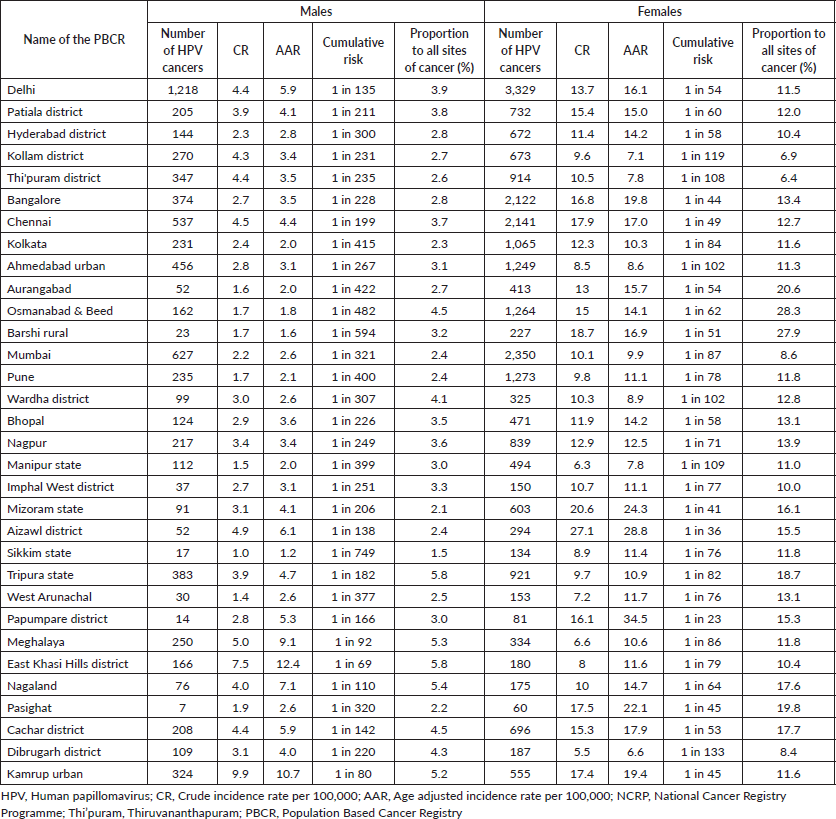
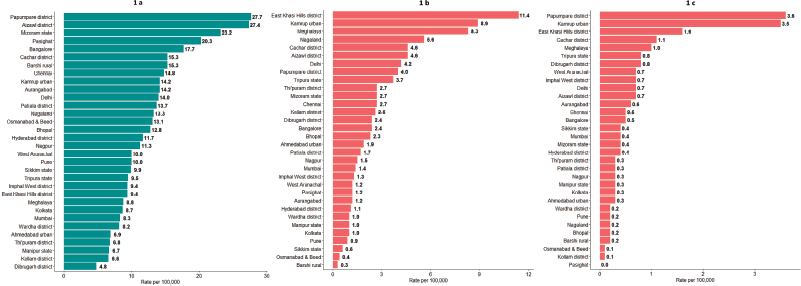
Figure 1. Age adjusted incidence rates in 28 PBCRs under NCRP. (a): Cervical cancer (C53), (b): Oropharyngeal cancer (C09-10) - males and (c): Oropharyngeal cancer (C09-10) – females.
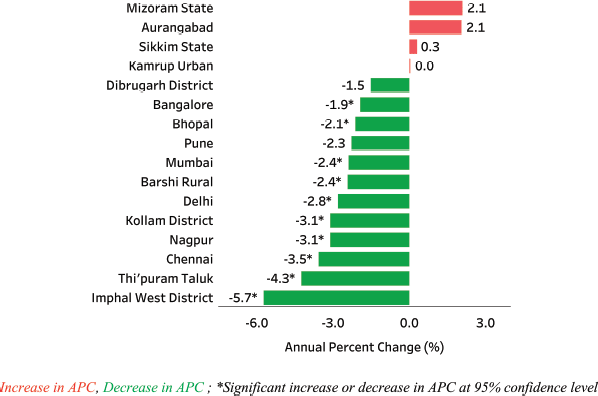
Figure 2. Annual Percent Change (APC) in age adjusted incidence rates (AARs) over the time period for cervical cancer (C53).
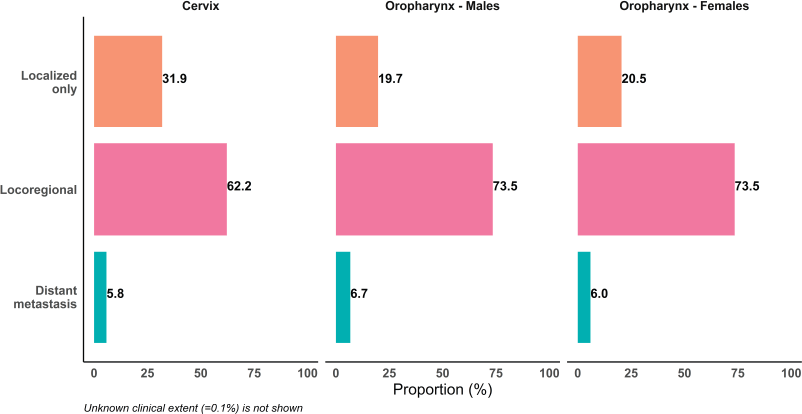
Figure 3. Proportion of patients according to the clinical extent of cancer for cervical (C53) and oropharyngeal cancer (C09-10) by gender reported in 96 HBCRs.
Cervical cancer incidence was higher among PBCRs in north eastern region of India. However, its incidence rate showed a decreasing trend among most of the PBCRs over time [17]. The study found that most of the cervical cancers were diagnosed at locally advanced stage. Late diagnosis of cervical cancers could be attributed to low level of knowledge and awareness on risk factors, screening, as well as poor screening and early detection coverage among Indian women [18–20].
A combination of radiotherapy and chemotherapy treatment was advised irrespective of the stage of disease with varied proportions of surgery. The treatment pattern observed in this study aligned with the existing evidence [21–23]. A multi-centric cervical cancer study from India showed that 5-year survival was significantly higher with chemoradiation compared to radiotherapy alone in locoregional stage [24]. HPV infection was the main cause for cervical cancers with PAF ranging between 93% and 100% in India [25]. Examination of cervical cancer cases from central India revealed that HPV types 16, 18 and 45 were predominant types [26]. The progression of cervical cancer from initial HPV infection is modified by other factors such as age at menarche, age at marriage, sexual habits, high parity, tobacco use, prolonged use of oral contraceptives and co-infections (particularly Human Immunodeficiency Virus) [27]. Hence, prevention of cervical cancer includes screening, vaccination and behaviour change interventions.
The study found that six out of ten HPV related cancers among males were oropharyngeal cancers in India. A global study in 2017 attributed 22.0% (95% (confidence interval) CI: 5.0–44.0) of oropharyngeal cancer incidence in India to HPV infection [4]. However, recent studies among Indian population reported wide variations of HPV prevalence among oropharyngeal cancer cases ranging between 0.0% in south India and 44.4% in north, followed by west (26.7%) with HPV 16 and 58 as the predominant genotypes [28–33]. Reported variations in HPV prevalence among cancer cases in India are due to different detection methods, population, geographic locations and sample size. However, major proportion could be attributed to tobacco use (59.0%) and consumption of alcohol (4.7%) [34, 35]. Existing policies and programmes to prevent and control these risk factors should be reinforced to bring down cancer burden [36]. Stage at diagnosis (locoregional stage) and treatment provided (chemoradiation) were found to be in accordance with the existing evidence [37]. Also, a multi-institution study on survival of head and neck cancers showed that 5–year survival was significantly higher with stage I and II than Stage III and IV for oropharyngeal cancer [38].
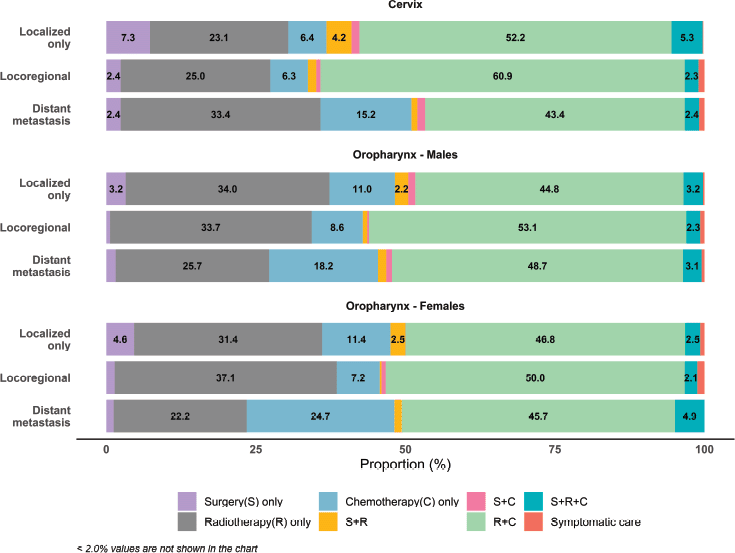
Figure 4. Proportion (%) of cancer patients according to type of treatment and clinical extent of the cancer for cervical (C53) and oropharyngeal cancer (C09-10) by gender reported in 96 HBCRs.
Vulval and vaginal cancers are rare cancers that showed minor decline in incidence for longer term in India [39]. HPV infection was more common among young women leading to basaloid/warty lesions in vulva. The PAF to HPV infection by anus and anal canal (100%), vaginal cancer (78.0%; 95% CI: 68.0–86.0) and vulval cancer (30.3%; 95% CI: 25.3–35.0) was found to be high compared to laryngeal cancer (1.1; 95% CI: 0.1–5.1) and oral cavity cancer (1.4% 95% CI: 0.4–3.2) [1, 4].
Penile and anal cancer together constitutes 1.2% of total cancer cases in India. Globally, more than half (51.0%) of the penile cancers were attributed to HPV infection with PAF ranging between 47.0% and 55.0% [25]. This indicates a projected 3,337 HPV attributable penile cancers for 2025 in India. HPV 16, 18 and 33 are the predominant genotypes in anal, vulvar, vaginal and penile cancers [40–42]. Although India contributes to around 10% to total anus and anal cancer cases globally, trend analysis indicates stability in the incidence of anus and anal cancer for India [43].
HPV vaccines were licensed in 2008 for adolescent girls in India to be used on prescription base. Further, efforts were taken through demonstration vaccination projects, opportunistic screening and population-based screening [44–47]. However, poor screening coverage, low level of knowledge and awareness on risk factors, screening, HPV infection and vaccination among Indian women are hindering the cervical cancer control [8, 19, 48]. Growing population, ageing and changing sexual behaviour might avert the declining incidence trend in the absence of interventions as experienced in other settings [49]. It is estimated that in a medium Human Development Index country like India, efforts for scaling up HPV vaccination covering 80%–100% of target population together with two cervical cancer screenings per lifetime would help in achieving cervical cancer elimination by 2065-70 [50].
Table 2. Projected number of HPV related cancer incidence for India in 2025.

Strengths and limitations
The main strength of the study is the use of high-quality data from HBCRs and PBCRs under the NCRP that are spread across the country. The data were abstracted from multiple sources such as cancer care hospitals, laboratories, and vital statistics departments using well trained registry staff, and cleaned using a robust quality check mechanism. Although the NCRP provides reliable information on incidence and treatment of malignant cancers related to HPV, they do not collect data pertaining to HPV genotype status and other risk factors.
Conclusion
One out of 13 cancers in India is from HPV related sites. Implementation of effective prevention and control strategies like HPV vaccination and scaling up of screening, risk factor reduction could reduce the burden of HPV related cancers. Evidence from the NCRP serves as the baseline to monitor the impact of HPV policies and programmes in improving the outcome and prognosis.
List of abbreviations
AAR, Age adjusted incidence rate; APC, Annual percentage change; CR, Crude incidence rate; HBCR, Hospital Based Cancer Registry; HPV, Human papillomavirus; IARC, International Agency for Research on Cancer; ICMR, Indian Council of Medical Research; NCDIR, National Centre for Disease Informatics and Research; NCRP, National Cancer Registry Programme; PBCR, Population Based Cancer Registry
Conflicts of interest
The authors declare no conflicts of interest.
Funding statement
The authors received no financial support for authorship of this article.
Authorship contribution
Thilagavathi Ramamoorthy: Conceptualisation, methodology, formal statistical analysis, writing – original draft, review and editing. Sathish Kumar Krishnan: Methodology, formal statistical analysis, data curation, writing – review and editing. Priyanka Das: Data curation, interpretation, writing – review and editing. Kondalli Lakshminarayana Sudarshan: Data curation, interpretation, writing – review and editing. Prashant Mathur: Conceptualisation, methodology, investigation, writing – review and editing, visualization, supervision, project administration. All authors have read and provided approval to the final version of the manuscript. The work reported in the paper has been performed by the authors, unless clearly specified in the text.
Ethical approval
This study was approved by the Institutional Ethics Committee of ICMR-NCDIR. Approval no: NCDIR/IEC/ 3052/2022.
Acknowledgments
The authors would like to acknowledge the contributions by the study investigators and staff under ICMR-NCDIR’s National Cancer Registry Programme.
References
1. de Martel C, Georges D, and Bray F, et al (2020) Global burden of cancer attributable to infections in 2018: a worldwide incidence analysis Lancet Glob Health 8(2) e180–e190 https://doi.org/10.1016/S2214-109X(19)30488-7
2. Cogliano V, Baan R, and Straif K, et al (2005) Carcinogenicity of human papillomaviruses Lancet Oncol 6(4) 204 https://doi.org/10.1016/S1470-2045(05)70086-3 PMID: 15830458
3. IARC Working Group on the Evaluation of Carcinogenic Risks to Humans (2012) Biological agents. Volume 100 B. A review of human carcinogens IARC Monogr Eval Carcinog Risks Hum 100 1–441
4. de Martel C, Plummer M, and Vignat J, et al (2017) Worldwide burden of cancer attributable to HPV by site, country and HPV type Int J Cancer 141(4) 664–670 https://doi.org/10.1002/ijc.30716 PMID: 28369882 PMCID: 5520228
5. WHO (2019) Draft: global strategy towards the elimination of cervical cancer as a public health problem Geneva: Word Health Organization [https://www.who.int/publications/m/item/draft-global-strategy-towards-eliminating-cervical-cancer-as-a-public-health-problem] Data accessed: 5/03/22
6. Sung H, Ferlay J, and Siegel RL, et al (2021) Global cancer statistics 2020: GLOBOCAN estimates of incidence and mortality worldwide for 36 cancers in 185 countries CA Cancer J Clin 71(3) 209–249 https://doi.org/10.3322/caac.21660 PMID: 33538338
7. Basu P, Roychowdhury S, and Bafna UD, et al (2009) Human papillomavirus genotype distribution in cervical cancer in India: results from a multi-center study Asian Pac J Cancer Prev APJCP 10(1) 27–34 PMID: 19469620
8. Senapati R, Nayak B, and Kar SK, et al (2017) HPV genotypes distribution in Indian women with and without cervical carcinoma: implication for HPV vaccination program in Odisha, Eastern India BMC Infect Dis 17(1) 30
9. Ministry of Health and Family Welfare, Government of India (2022) National Programme for Prevention & Control of Cancer, Diabetes, Cardiovascular Diseases & Stroke (NPCDCS): National Health Mission [https://nhm.gov.in/index1.php?lang=1&level=2&sublinkid=1048&lid=604] Data accessed: 15/03/22
10. ICMR-NCDIR (2020) Report of National Cancer Registry Programme (2012–2016) [
11. ICMR-NCDIR (2021) Clinicopathological Profile of Cancers in India: A Report of the Hospital Based Cancer Registries [
12. Ferlay J, Ervik M, and Lam F, et al (2020) Global Cancer Observatory: Cancer Today (Lyon: International Agency for Research on Cancer)
13. Office of the Registrar General & Census Commissioner (2011) Census 2011 (Ministry of Home Affairs, Government of India)
14. Takiar R and Shobana B (2009) Cancer incidence rates and the problem of denominators-a new approach in Indian cancer registries Asian Pac J Cancer Prev 10(1) 123–126 PMID: 19469639
15. Segi M (1960) Cancer Mortality for Selected Sites in 24 Countries 1950–1957 (Sendai: The Department of Public Health, Tohoku University School of Medicine)
16. National Cancer Institute Joinpoint Trend Analysis Software (Version 4.8.0.1) [https://www.surveillance.cancer.gov/joinpoint/]
17. Sathishkumar K, Vinodh N, and Badwe RA, et al (2021) Trends in breast and cervical cancer in India under National Cancer Registry Programme: an age-period-cohort analysis Cancer Epidemiol 74 101982 https://doi.org/10.1016/j.canep.2021.101982 PMID: 34280846
18. Kadian L, Gulshan G, and Sharma S, et al (2021) A study on knowledge and awareness of cervical cancer among females of rural and urban areas of Haryana, North India J Cancer Educ 36(4) 844–849 https://doi.org/10.1007/s13187-020-01712-6
19. Krishnamoorthy Y, Ganesh K, and Sakthivel M (2021) Prevalence and determinants of breast and cervical cancer screening among women aged between 30 and 49 years in India: secondary data analysis of National Family Health Survey–4 Indian J Cancer [Advance online publication]
20. Oswal K, Kanodia R, and Pradhan A, et al (2020) Assessment of knowledge and screening in oral, breast, and cervical cancer in the population of the northeast region of India JCO Glob Oncol 6 601–609 https://doi.org/10.1200/JGO.19.00257 PMID: 32302235 PMCID: 7193798
21. Petignat P and Roy M (2007) Diagnosis and management of cervical cancer BMJ 335(7623) 765–768 https://doi.org/10.1136/bmj.39337.615197.80 PMID: 17932207 PMCID: 2018789
22. Kundargi RS, Guruprasad B, and Hanumantappa N, et al (2013) The role of surgery in locally advanced carcinoma of cervix after sub-optimal chemoradiation: Indian scenario South Asian J Cancer 2(3) 137–139 https://doi.org/10.4103/2278-330X.114119
23. Li H, Pang Y, and Cheng X (2019) Surgery of primary sites for stage IVB cervical cancer patients receiving chemoradiotherapy: a population-based study J Gynecol Oncol 31(1) e8 PMID: 31788998 PMCID: 6918894
24. Nandakumar A, Rath GK, and Kataki AC, et al (2015) Concurrent chemoradiation for cancer of the cervix: results of a multi-institutional study from the setting of a developing country (India) J Glob Oncol 1(1) 11–22 https://doi.org/10.1200/JGO.2015.000877 PMID: 28804767 PMCID: 5551651
25. Plummer M, de Martel C, and Vignat J, et al (2016) Global burden of cancers attributable to infections in 2012: a synthetic analysis Lancet Glob Health 4 e609–e616 https://doi.org/10.1016/S2214-109X(16)30143-7 PMID: 27470177
26. Gheit T, Vaccarella S, and Schmitt M, et al (2009) Prevalence of human papillomavirus types in cervical and oral cancers in central India Vaccine 27(5) 636–639 https://doi.org/10.1016/j.vaccine.2008.11.041
27. Bhat D (2022) The ‘Why and How’ of cervical cancers and genital HPV infection Cytojournal 19 22 https://doi.org/10.25259/CMAS_03_03_2021 PMID: 35510113 PMCID: 9063509
28. Dalakoti P, Ramaswamy B, and Bhandarkar AM, et al (2019) Prevalence of HPV in oral squamous cell carcinoma in South West India Indian J Otolaryngol Head Neck Surg 71(Suppl 1) 657–664 https://doi.org/10.1007/s12070-018-1470-9 PMID: 31742038 PMCID: 6848302
29. Laprise C, Madathil SA, and Allison P, et al (2016) No role for human papillomavirus infection in oral cancers in a region in southern India Int J Cancer 138(4) 912–917 https://doi.org/10.1002/ijc.29827
30. Thobias AR, Patel KA, and Bhatt SD, et al (2021) Human papillomavirus: footprints in the population of western India Epidemiol Health 43 e2021013 https://doi.org/10.4178/epih.e2021013 PMID: 33541009 PMCID: 8060527
31. Gholap D, Mhatre S, and Chaturvedi P, et al (2022) Prevalence of human papillomavirus types in head and neck cancer sub-sites in the Indian population ecancer 16 1358 https://doi.org/10.3332/ecancer.2022.1358
32. Rajesh D, Mohiyuddin SMA, and Kutty AVM, et al (2017) Prevalence of human papillomavirus in oral squamous cell carcinoma: a rural teaching hospital-based cross-sectional study Indian J Cancer 54(3) 498–501 https://doi.org/10.4103/ijc.IJC_272_17
33. Bandhary SK, Shetty V, and Saldanha M, et al (2018) Detection of human papilloma virus and risk factors among patients with head and neck squamous cell carcinoma attending a tertiary referral centre in South India Asian Pac J Cancer Prev 19(5) 1325–1330 PMID: 29802694 PMCID: 6031850
34. Rumgay H, Shield K, and Charvat H, et al (2021) Global burden of cancer in 2020 attributable to alcohol consumption: a population-based study Lancet Oncol 22(8) 1071–1080 https://doi.org/10.1016/S1470-2045(21)00279-5 PMID: 34270924 PMCID: 8324483
35. Prasad JB and Dhar M (2020) Assessment and projection of burden of cancer due to tobacco in India till 2025 Clin Epidemiol Glob Health 8(4) 1067–1071 https://doi.org/10.1016/j.cegh.2020.03.021
36. Ministry of Health and Family Welfare Government of India National Multisectoral Action Plan for Prevention and Control of Common Noncommunicable Diseases (2017–2022) [https://main.mohfw.gov.in/sites/default/files/National%20Multisectoral%20Action%20Plan%20%28NMAP%29%20for%20Prevention%20and%20Control%20of%20Common%20NCDs%20%282017-22%29_1.pdf] Data accessed: 15/04/22
37. Mathew A, George PS, and Ramadas K, et al (2019) Sociodemographic factors and stage of cancer at diagnosis: a population-based study in South India J Glob Oncol 5 1–10 PMID: 31322993 PMCID: 6690651
38. Nandakumar A and Nandakumar A (2016) Survival in head and neck cancers-results of a multi-institution study Asian Pac J Cancer Prev 17(4) 1745–1754 https://doi.org/10.7314/APJCP.2016.17.4.1745 PMID: 27221826
39. Bray F, Laversanne M, and Weiderpass E, et al (2020) Geographic and temporal variations in the incidence of vulvar and vaginal cancers Int J Cancer 147(10) 2764–2771 https://doi.org/10.1002/ijc.33055 PMID: 32410226
40. Alemany L, Saunier M, and Alvarado-Cabrero I, et al (2015) Human papillomavirus DNA prevalence and type distribution in anal carcinomas worldwide Int J Cancer 136(1) 98–107 https://doi.org/10.1002/ijc.28963
41. de Sanjosé S, Alemany L, and Ordi J, et al (2013) Worldwide human papillomavirus genotype attribution in over 2000 cases of intraepithelial and invasive lesions of the vulva Eur J Cancer 49(16) 3450–3461 https://doi.org/10.1016/j.ejca.2013.06.033 PMID: 23886586
42. Shukla S, Bharti AC, and Mahata S, et al (2009) Infection of human papillomaviruses in cancers of different human organ sites Indian J Med Res 130(3) 222–233 [
43. Islami F, Ferlay J, and Lortet-Tieulent J, et al (2017) International trends in anal cancer incidence rates Int J Epidemiol 46(3) 924–938
44. Sankaranarayanan R, Basu P, and Kaur P, et al (2019) Current status of human papillomavirus vaccination in India’s cervical cancer prevention efforts Lancet Oncol 20(11) e637–e644 https://doi.org/10.1016/S1470-2045(19)30531-5 PMID: 31674322
45. Indian Council of Medical Research (2011) Final Report of the Committee Appointed by the Government of India, vide notification no V 25011/160/2010-HR Dated 15th April, 2010, to Enquire into “Alleged Irregularities in the Conduct of Studies using Human Papilloma Virus (HPV) Vaccine” by PATH in India [https://main.icmr.nic.in/sites/default/files/reports/HPV_PATH_final_report.pdf] Data accessed: 29/03/22
46. Sankaranarayanan R, Prabhu PR, and Pawlita M, et al (2016) Immunogenicity and HPV infection after one, two, and three doses of quadrivalent HPV vaccine in girls in India: a multicentre prospective cohort study Lancet Oncol 17(1) 67–77 https://doi.org/10.1016/S1470-2045(15)00414-3
47. WHO (2017) Punjab launches HPV vaccine with WHO support [http://www.searo.who.int/india/mediacentre/events/2016/Punjab_HPV_vaccine/en/] Data accessed: 29/03/22
48. Oswal K, Kanodia R, and Pradhan A, et al (2020) Assessment of knowledge and screening in oral, breast, and cervical cancer in the population of the northeast region of India JCO Glob Oncol 6 601–609 https://doi.org/10.1200/JGO.19.00257 PMID: 32302235 PMCID: 7193798
49. Bray F, Lortet-Tieulent J, and Znaor A, et al (2013) Patterns and trends in human papillomavirus-related diseases in Central and Eastern Europe and Central Asia Vaccine 31(Suppl 7) H32–45 https://doi.org/10.1016/j.vaccine.2013.02.071 PMID: 24332296
50. Simms KT, Steinberg J, and Caruana M, et al (2019) Impact of scaled up human papillomavirus vaccination and cervical screening and the potential for global elimination of cervical cancer in 181 countries, 2020-99: a modelling study Lancet Oncol 20(3) 394–407 https://doi.org/10.1016/S1470-2045(18)30836-2 PMID: 30795950
Supplementary materials
Supplementary Table 1. Number and proportion of HPV related cancers in India.

Supplementary Table 2a. Proportion according to the broad histological classification - Cervical cancer (C53).
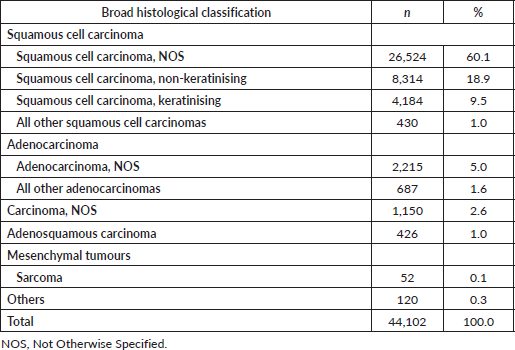
Supplementary Table 2b. Proportion according to the broad histological classification - Oropharyngeal cancer (C09-10).
